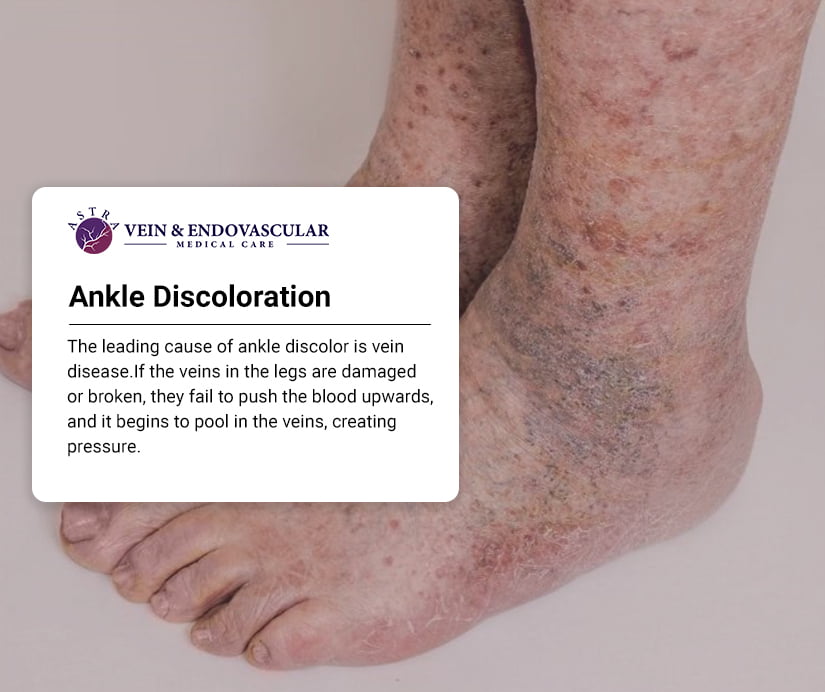
Most people take reddish or brown discoloration on the ankles due to some dermatological problem, but it may be more than that. Discoloration on your legs, ankle, and feet may be a sign of venous disease, venous hypertension, or chronic venous insufficiency that can turn serious if they are not treated timely. Schedule an appointment with Dr. George Bolotin at the Astra Vein Treatment Center to evaluate your discolored ankles and find more about effective treatment options.
The leading cause of ankle discolor is vein disease. Veins carry the blood back up to the heart. If the veins in the legs are damaged or broken, they fail to push the blood upwards, and it begins to pool in the veins, creating pressure. This condition is known as venous insufficiency. If this condition is left untreated, it results in blood leaking from the veins to the skin, causing the skin to become red, dry, itchy, and irritated. It is called venous stasis dermatitis.
When blood pools in the skin of the legs, the iron in the red blood cells begin to collect in the skin and break down into hemosiderin that appears as purple or brown discoloration.
Discolored ankles cause concern if they result from chronic venous insufficiency or some other medical condition. It is essential to have your staining ankles checked by an experienced vein physician to know their possible causes and treatment plans.

Veins are responsible for returning the deoxygenated blood to the heart. The veins in the leg have to fight gravity and other factors to force the blood upwards efficiently. Poor blood flow from the veins can affect the ankles and legs, leaving behind hemosiderin deposits.
Hemosiderin is a protein compound that stores iron from the blood in the body tissues. When hemosiderin deposits accumulate under the skin due to insufficient blood flow, it cannot return the excess iron into the immune system to clear away, leaving dark pigmentation in the ankles known as stasis dermatitis.
Veins damaged due to faulty valves can become varicose. When valves in the vein function correctly, they allow the blood to pass through on its route back to the heart. In case of any problem, they can prevent some of the blood from going back, and it begins to pool in the feet, ankles, and legs, leading to thick, gnarled veins known as varicose veins.
Ankle discoloration and swelling are common symptoms of varicose veins. They not only appear unsightly but also affect your skin health. If they are not cared for timely, varicose veins can lead to other issues, too, such as edema and venous stasis ulcers.
If veins get damaged due to an injury, surgical procedures, or any other reason, it can lead to deep vein thrombosis (DVT) that can also cause ankle discoloration.
The first step in diagnosing the causes of discoloration below the ankle is a physical exam. During this evaluation, the vein expert doctor will also use a color duplex ultrasound that creates an image of your veins with the help of specialized software. This ultrasound enables the doctor to see blood clots, changes to the blood vessels in the legs and ankles, and reduced blood flow that need attention.
Your doctor may use Magnetic Resonance Venography (MRV), a diagnostic procedure that utilizes a combination of a large magnet, radio frequencies, and a computer to produce detailed images of body organs and structures. With the help of MRV, the doctor will be able to diagnose the causes and get rid of foot and ankle skin discoloration.
The doctor will also check your legs and ankles for visible bruising, swelling, warmth, and tenderness to know more about your condition and come up with the best solutions to provide relief.
Your doctor will suggest the best treatment options depending on the causes and severity of your sudden ankle discoloration.
Some popular ways for managing ankle discoloration and reducing its effect include:
Compression therapy
Doctors recommend custom-fitted medical stockings to improve the blood circulation in your legs that is the leading cause of ankle discoloration. The compression stockings squeeze your legs to encourage the blood to flow past the faulty valves and back up to your heart, instead of pooling in the lower extremities and causing damage.
Lifestyle changes
Lifestyle changes matter a lot in improving your blood circulation and preventing venous insufficiency.
Doctors suggest the following changes in your lifestyle to prevent vein disease:
Lifestyle changes such as walking regularly and avoiding standing or sitting in one position for a long time, combined with compression therapy, helps to promote a healthy flow of blood to the heart.
If compression socks and lifestyle changes fail to deliver desired results and treat venous insufficiency effectively, your doctor may recommend minimally invasive procedures as the next step. They include:
These minimally invasive procedures offer quick recovery and results. Venous insufficiency is resolved when the blood in the legs is redirected to healthier veins that prevent blood from pooling again, and the immune system clears the hemosiderin deposits.
Discoloration at the ankle not only appears unsightly but can also affect your self-confidence and esteem. You can get rid of the staining around your legs and manage the accompanying pain and discomfort by seeking medical advice from an expert vein doctor. At the Astra Vein Treatment Center, Dr. Bolotin will explain ankle discoloration’s causes and treatment options to help you better manage your condition and enjoy a healthy life.
Vein & Vascular Medical Care
4209 Ave U, Suite A.
Brooklyn, NY 11234
(347) 934-9068
Vein & Vascular Medical Care
869 E Tremont Ave
Bronx, NY 10460
(929) 447-4563